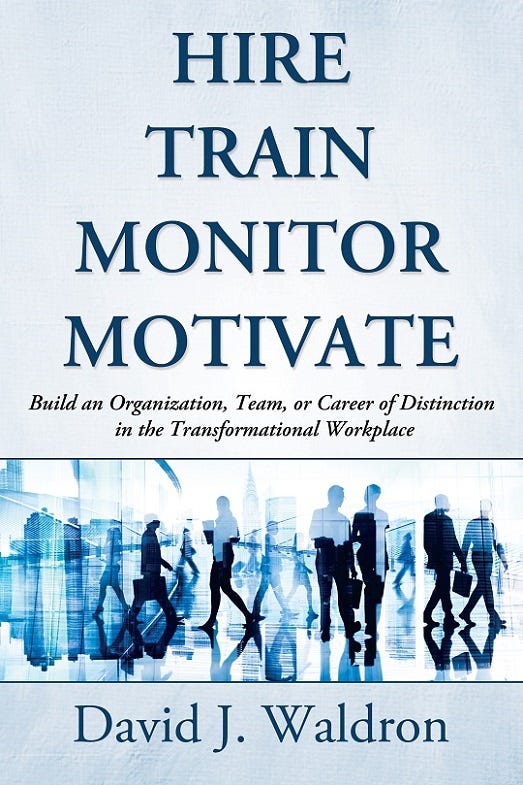Chapter Three: Master the Art of Workplace Transformation | Part 1 of 4
Revised and updated | Hire Train Monitor Motivate: Build an Organization, Team, or Career of Distinction in the Transformational Workplace
Audio voiceover:
Substack’s AI-generated voiceover is now available from David J. Waldron. To access it, open the chapter in the Substack app. Feel free to share your thoughts in the comments or via direct message. I will use AI to clone my voice for the book’s official audiobook release.
Learn more about audio voiceovers:
https://davidjwaldronbooks.substack.com/p/audio
Haven’t read the previous chapters? You can find them here on my webpage:
https://davidjwaldronbooks.substack.com/p/hire-train-monitor-motivate
Chapter Three
Master the Art of Workplace Transformation
Part 1 of 4: Hire for Optimism
Customer-centered, teamwork-focused, and consensus-driven organizations are dedicated to excellence in recruiting and retaining employees who educate and serve their constituents. The ongoing responsibility is to hire, train, monitor, and motivate passionate contributors who focus on achieving the desired customer and organizational outcomes.
I was fortunate to serve successful tenures in organizational leadership and team building by learning and practicing the art of hiring, training, monitoring, and motivating. These four skills, when combined, are essential for building and maintaining an organization, a team, or an individual’s career of distinction.
Hire for Optimism
As discussed in Chapter One: “First People, Then Vision,” and Chapter Two: “Build an Organization, Team, or Career of Distinction,” hiring or referring the best talent and practicing effective career management are essential. This productive recruiting method is counterintuitive to the traditional focus on qualifications and technical skills in today’s credential-obsessed and competitive work environments.
The key is to broaden your search beyond the essential checks and balances of matching candidates to the departmental or corporate human resource requirements. Build a team of excellence by hiring or referring qualified individuals with positive mindsets. Alternatively, maintain an attitude of distinction as an individual contributor. In either case, positive energy fuels a winning team.
The Group Interview Revisited
Consider a different approach to group interviews. Flip the script by first showcasing your organization or department and its job opportunities professionally and engagingly. Then allow your guests to leave the building during a scheduled break if they feel the job or culture does not fit them.
No hard feelings. As you mentioned in your opening statement, it’s okay to exit gracefully. The department and organization wish everyone great success in their future career endeavors. Regarding the candidates who choose to return from the intermission, rest assured that you have the undivided attention of those individuals.
Now, have each participant share with the entire group why they believe they are the best candidate for the job opportunity presented and why they deserve a scheduled formal interview. Then, ask each candidate to vote anonymously for their choice, excluding themselves, and to include a brief narrative explaining why. You might be amazed by the results.
If you are not a hiring manager, consider referring candidates to the group seminar or volunteering to assist with the festivities. I guarantee that you will experience joy from the fruits of your labor in contributing to the growth and development of your organization or team.
I have hired some of my best employees from group interviews. The cream rises to the top. The winners often emerge at the starting gate.
Turn the Tables During the One-on-One Interview
As an alternative, utilize the same presentation and approach as the group interview to convey the job opening during the one-on-one interview. In the opening statement, allow the candidate to end the meeting at any time if the opportunity doesn’t meet their expectations.
When choosing to remain, as a majority often does in the individual format, ask the interviewee to explain at the end why they are the best fit for the job. Invite back those who impress for a more formal interview.
Once hired, the most dedicated employees may sometimes submit a letter of resignation because a once-in-a-lifetime opportunity was found that you were unable to match, or perhaps there is an unexpected relocation of a spouse or partner. Surprises such as these are why you need to be interviewing in regular intervals, regardless of whether openings exist. Put more memorably:
Maintain blue suits in the lobby or the online candidate queue.
Employees Join Organizations, But They Leave Managers
It is often observed that selected candidates join organizations with enthusiasm but later leave their managers or supervisors feeling disdain. As an individual candidate, be just as inquisitive when vetting potential future supervisors and coworkers as you are with the recruiting organization.
When hiring or referring, be bold and confident, and provide the candidate reasonable access to supervisors or coworkers. This vetting process may help prevent the common issue of good employees leaving bad or incompatible managers after joining an organization, or vice versa.
Recruit or refer new hires who possess genuine positive attitudes at the starting gate, and perhaps never worry again about colleagues sprouting negative outlooks in your workplace. Optimistic minds produce positive results, creating great places to work.
Next in Hire Train Monitor Motivate | Chapter Three: Master the Art of Workplace Transformation | Part 2 of 4 — Train for Quality
Hire Train Monitor Motivate is copyright 2016 and 2025 by David J. Waldron. All rights reserved worldwide.
Universal links allow you to preview or purchase David’s published print or ebooks—each available globally at your preferred online bookstores—with one or two clicks, brought to you by our trusted partner, BookFunnel.








